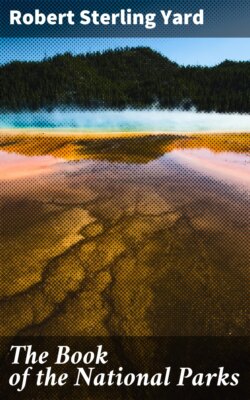Читать книгу The Book of the National Parks - Robert Sterling Yard - Страница 14
На сайте Литреса книга снята с продажи.
IV
ОглавлениеOriginally the motive in park-making had been unalloyed conservation. It is as if Congress had said: "Let us lock this up where no one can run away with it; we don't need it now, but some day it may be valuable." That was the instinct that led to the reservation of the Hot Springs of Arkansas in 1832, the first national park. Forty years later, when official investigation proved the truth of the amazing tales of Yellowstone's natural wonders, it was the instinct which led to the reservation of that largely unexplored area as the second national park. Seventeen years after Yellowstone, when newspapers and scientific magazines recounted the ethnological importance of the Casa Grande Ruin in Arizona, it resulted in the creation of the third national park, notwithstanding that the area so conserved enclosed less than a square mile, which contained nothing of the kind and quality which to-day we recognize as essential to parkhood. This closed what may be regarded as the initial period of national parks conservation. It was wholly instinctive; distinctions, objectives, and policies were undreamed of.
Less than two years after Casa Grande, which, by the way, has recently been re-classed a national monument, what may be called the middle period began brilliantly with the creation, in 1890, of the Yosemite, the Sequoia, and the General Grant National Parks, all parks in the true sense of the word, and all of the first order of scenic magnificence. Nine years later Mount Rainier was added, and two years after that wonderful Crater Lake, both meeting fully the new standard.
What followed was human and natural. The term national park had begun to mean something in the neighborhoods of the parks. Yellowstone and Yosemite had long been household words, and the introduction of other areas to their distinguished company fired local pride in neighboring states. "Why should we not have national parks, too?" people asked. Congress, always the reflection of the popular will, and therefore not always abreast of the moment, was unprepared with reasons. Thus, during 1903 and 1904, there were added to the list areas in North Dakota, South Dakota, and Oklahoma, which were better fitted for State parks than for association with the distinguished company of the nation's noblest.
A reaction followed and resulted in what we may call the modern period. Far-sighted men in and out of Congress began to compare and look ahead. No hint yet of the splendid destiny of our national parks, now so clearly defined, entered the minds of these men at this time, but ideas of selection, of development and utilization undoubtedly began to take form. At least, conservation, as such, ceased to become a sole motive. Insensibly Congress, or at least a few men of vision in Congress, began to take account of stock and figure on realization.
This healthy growth was helped materially by the public demand for the improvement of several of the national parks. No thought of appropriating money to improve the bathing facilities of Hot Springs had affected Congressional action for nearly half a century; it was enough that the curative springs had been saved from private ownership. Yellowstone was considered so altogether extraordinary, however, that Congress began in 1879 to appropriate yearly for its approach by road, and for the protection of its springs and geysers; but this was because Yellowstone appealed to the public sense of wonder. It took twenty years more for Congress to understand that the public sense of beauty was also worth appropriations. Yosemite had been a national park for nine years before it received a dollar, and then only when public demand for roads, trails, and accommodations became insistent.
From a photograph by Pillsbury
THE YOSEMITE FALLS—HIGHEST IN THE WORLD
From the brink of the upper falls to the foot of the lower falls is almost half a mile
But, once born, the idea took root and spread. It was fed by the press and magazine reports of the glories of the newer national parks, then attracting some public attention. It helped discrimination in the comparison of the minor parks created in 1903 and 1904 with the greater ones which had preceded. The realization that the parks must be developed at public expense sharpened Congressional judgment as to what areas should and should not become national parks.
From that time on Congress has made no mistakes in selecting national parks. Mesa Verde became a park in 1905, Glacier in 1910, Rocky Mountain in 1915, Hawaii and Lassen Volcanic in 1916, Mount McKinley in 1917, and Lafayette and the Grand Canyon in 1919. From that time on Congress, most conservatively, it is true, has backed its judgment with increasing appropriations. And in 1916 it created the National Park Service, a bureau of the Department of the Interior, to administer them in accordance with a definite policy.
